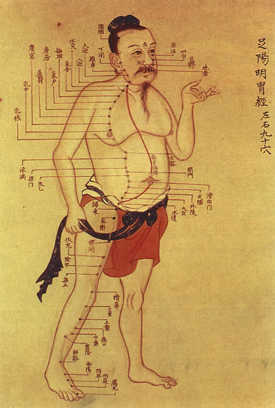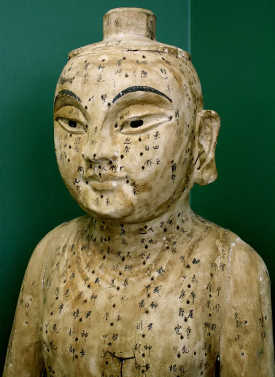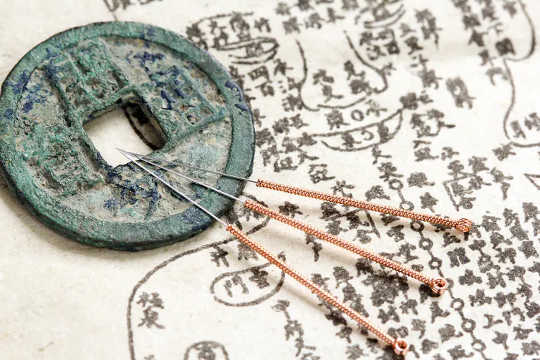The accepted history of anatomy says that it was the ancient Greeks who mapped the human body for the first time. Galen, the “Father of Anatomy”, worked on animals, and wrote anatomy textbooks that lasted for the next 1,500 years. Modern anatomy started in the Renaissance with Andreas Vesalius, who challenged what had been handed down from Galen. He worked from human beings, and wrote the seminal “On the Fabric of the Human Body”.
Scientists from ancient China are never mentioned in this history of anatomy. But our new paper shows that the oldest surviving anatomical atlas actually comes from Han Dynasty China, and was written over 2,000 years ago. Our discovery changes both the history of medicine and our understanding of the basis for acupuncture – a key branch of Chinese medicine.
There is an ever increasing body of evidence-based research that supports the efficacy of acupuncture for conditions as varied as migraine to osteoarthritis of the knee. The most recent draft NICE guidelines, published in August 2020, recommend the use of acupuncture as a first line treatment for chronic pain.
During an acupuncture treatment session, fine needles are inserted into the body at specific points (acupoints) in order to promote self healing. This happens because the needles (somehow) create balance in the life force or “Qi” of the person. How this happens is the subject of much research. The underlying assumption is that acupoints have some as yet undiscovered physiological property that is probably neurologically based.
Get The Latest By Email
Ancient Chinese texts
 Mawangdui Manuscript, ink on silk, 2nd century BCE. © Hunan Province Museum
Mawangdui Manuscript, ink on silk, 2nd century BCE. © Hunan Province Museum
The texts we worked on are the Mawangdui medical manuscripts, which were lost to us for two millenia. They were written during the Han dynasty and were so valued that a copy was buried with the body of Lady Dai, a Han dynasty aristocrat in 168 BCE. The tombs of Lady Dai and her family were opened in 1973, and the Mawangdui manuscripts were discovered.
They are clearly precursors to the famous acupuncture texts of the Yellow Emperor’s Canon of Internal Medicine (Huangdi Neijing), which was copied and recopied through history, and is revered in China as the source of acupuncture theory and practice. The descriptions of meridians and points found in it are still the basis of traditional Chinese medicine today.
The earlier Mawangdui texts don’t actually mention acupuncture points, and the descriptions they give of meridians are simpler and less complete. But some passages from them have clearly been directly copied into the Yellow Emperor’s Canon, all of which shows that these texts were written first.
Meridian pathways have always been interpreted as being based on esoteric ideas about the flow of vital energy “Qi” rather than as empirical descriptions of the body. But what the Mawangdui text describes is a set of meridians – pathways through the body. In later texts, these are usually illustrated pictorially as lines on the skin.
A meridian is described in terms of how it progresses through the body. The arm tai yin meridian, for instance, is described as starting in the centre of the palm, running along the forearm between the two bones, and so on. We wondered: what if these descriptions are not of an esoteric energy pathway, but of physical anatomical structures?
Dissecting history
To find out, we did detailed dissections of the human body, looking for pathways which ran through it along the routes described in the Mawangdui.
This is a very different view of the body than that of the Western scientist. In modern western medicine, the body is divided into systems that each have their own distinct function: like the nervous system or cardiovascular system.
That clearly wasn’t what the writers of the Mawangdui were doing. Their descriptions are more focused on how different structures interlink to create a flow through the body. They pay no attention to the specific function of the structures. We think this is because these scientists were making their observations of the human body for the first time, and purely described what they saw.
For our research, the anatomical substance of the work had to be unearthed by carefully replicating the authors’ scientific dissections. This was problematic. They had left us no pictures of what they were describing, so we had to reconstruct from their texts. Later Chinese anatomists, from the Song dynasty, did make pictures. These works were based on the recorded dissections of a criminal gang for whom dissection was a part of their punishment.
Then there was the issue of translation: so much can get lost when we translate texts, especially ancient ones, and one of us (Vivien) spent huge amounts of time cross-checking and confirming translations of the meridian descriptions. Finally, we had to look at Han-era society and show that anatomical examination would fit in their cultural context.
What we found was very exciting. Each of the Mawangdui meridians mapped onto major structures of the human body. Some of these structures are visible only to anatomists through dissection, and cannot be seen in the living person. To return to arm tai yin, for instance, the pathway is described at the elbow as going “below the sinew to the bicep”. When we look at the dissected human elbow, there is a flat band of tissue called the bicipital aponeurosis, and the arteries and nerves of the arm pass underneath it.
We think this is what the ancient Chinese anatomists were describing. There is no way to know about these structures except by doing anatomy, or reading the work of someone who has.
 An ancient acupuncture statue. Traditional and Modern Medicine/Flickr, CC BY
An ancient acupuncture statue. Traditional and Modern Medicine/Flickr, CC BY
The implications
We therefore believe that the Mawangdui manuscripts are the world’s oldest surviving anatomical atlas based on direct observation of the human body. The authors’ purpose presumably was to record the human body in detail. Anatomical examination of this kind would have been a rare privilege, available only to a select group of scientists favoured by the Emperor. It is likely that the purpose of the texts was expressly to pass this knowledge on to others. Physicians and students of medicine could use the texts to learn about anatomy, and engage in medical debate based on a sound knowledge of the human body.
This gives us new insights into the scientific prowess of Han dynasty China, which is famous for its wealth of discoveries. That Han scientists also did anatomy would make perfect sense, and adds richness to our understanding of their science.
Our work also has fundamental implications for acupuncture theory and so for modern research. The Yellow Emperor’s Canon quite clearly draws on and develops the content of the Mawangdui. If the Mawangdui is an anatomical atlas, it is highly likely that the succeeding texts are grounded in anatomy too.
The research shines a light on the hitherto unrecognised contributions of Chinese anatomists, and repositions them at the centre of the field. This new information challenges the perceived esoteric nature of acupuncture, and roots it instead in anatomical science.
About the Authors
Vivien Shaw, Lecturer in Anatomy, Bangor University and Isabelle Catherine Winder, Lecturer in Zoology, Bangor University
This article is republished from The Conversation under a Creative Commons license. Read the original article.
books_acupuncture








